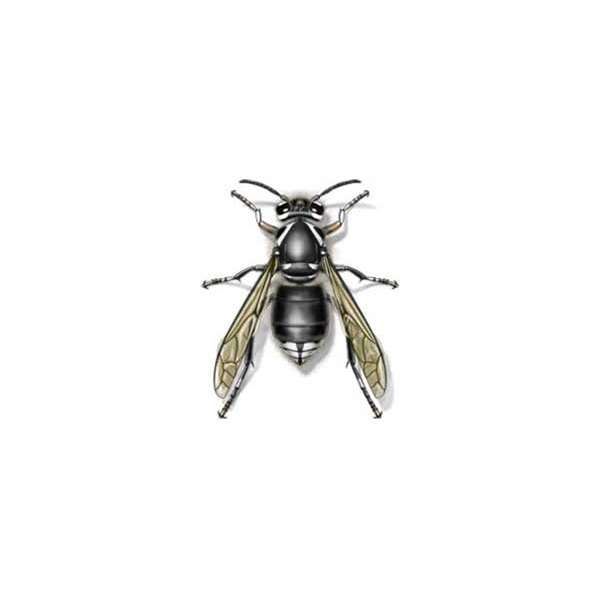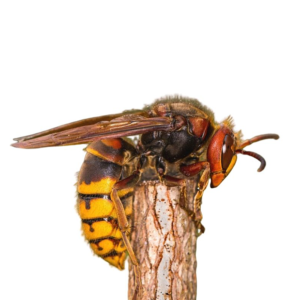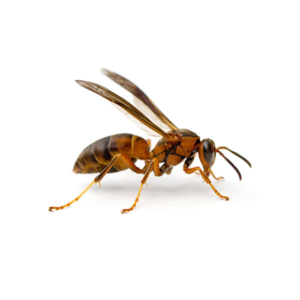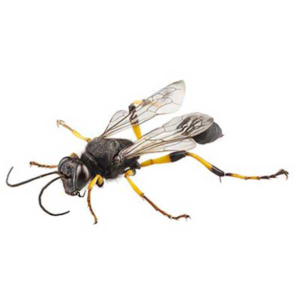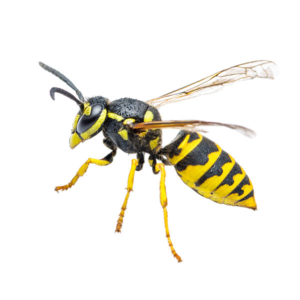Bald-Faced Hornet Identification
What Do Bald-Faced Hornets Look Like?
Bald-faced hornets are large, black wasps with distinctive white markings. They measure about ¾ to 1 inch in length. Their bodies are mostly black, with white markings on their faces, thoraxes, and the tips of their abdomens. Bald-faced hornets have two pairs of wings, with the forewings larger than the hind wings. They have powerful mandibles for capturing prey and a narrow waist.
Signs of a Bald-Faced Hornet Infestation
Signs of a bald-faced hornet infestation may include increased hornet activity, particularly around their nest site. Bald-faced hornet nests are typically large, grayish paper-like structures attached to trees, shrubs, or buildings. You may notice buzzing sounds near the nest as hornets enter and exit. Additionally, bald-faced hornets are territorial and may exhibit aggressive behavior if their nest is disturbed. Visual identification of the nest and observation of hornet activity are key indicators of an infestation.
Habitat, Diet, Life Cycle & Stings
Where Do Bald-Faced Hornets Live?
The bald-faced hornet is more likely to build its large, paper nest around areas where humans live, work, and play. These hornets build gray-colored, egg-shaped nests that can become quite large, some growing to 24 inches in length and 30 inches in diameter. Nests are created in spring and early summer by worker hornets chewing on natural wood fibers. Bald-faced hornets will construct nests in trees, under eaves, around light structures on buildings, and inside children’s playhouses. When the nest is finished, it will be the size of a football or basketball.
Diet of a Bold-Faced Hornet
Bald-faced hornets are carnivorous insects, primarily feeding on other insects and occasionally scavenging for sugary substances. They capture a variety of prey, including flies, caterpillars, spiders, and other small arthropods, using their powerful mandibles. After subduing their prey, they chew it into small pieces and feed it to their developing larvae in the nest. While adult bald-faced hornets primarily feed on protein-rich insects, they may also visit flowers to consume nectar for energy, making them occasional pollinators.
Life Cycle of a Bold-Faced Hornet
The life cycle of a bald-faced hornet begins when a mated queen emerges from hibernation in spring to establish a new colony. She constructs a small paper-like nest and lays eggs, which hatch into larvae. The queen feeds and cares for the larvae until they pupate. After pupation, they emerge as sterile female workers, which take over nest-building and foraging duties. Throughout the summer, the colony grows in size. In fall, new queens and males are produced, mating occurs, and fertilized queens overwinter to start new colonies the following spring.
Do Bold-Faced Hornets Sting?
Bald-faced hornet stings are venomous and can cause pain and swelling for about 24 hours. People who are allergic to bee stings may have similar reactions to a bald-faced hornet sting. Bald-faced hornets scavenge in trash receptacles and forage upon food and beverages consumed outdoors. They also consume ripe fruit in gardens, farms, and vineyards. In the autumn, the combination of cooler temperatures and reduced food stimulates newly emerged reproductive wasps to seek warm shelter, and they are more likely to invade homes.
As with many stinging insects, these pests will sting if they feel threatened or their nest is in danger. If a nest is located near human activity, it is important to contact a professional hornet control company for stinging insect control or nest removal.
Are Bald-Faced Hornets Dangerous?
Bald-faced hornets can be considered dangerous due to their aggressive defense of their nests. While they are not typically aggressive towards humans unless provoked, disturbing their nest can trigger defensive behavior, leading to painful stings. Their venom contains toxins that can cause pain, swelling, and allergic reactions in some individuals. In addition, bald-faced hornets can sting multiple times, making encounters with them potentially hazardous, especially for those with allergies to insect stings. If you are stung, seek medical advice immediately.
Bald-Faced Hornet Prevention Tips
To prevent bald-faced hornet infestations:
- Regular Inspection: Inspect your property to identify potential nest sites, such as trees, shrubs, or buildings.
- Nest Removal: Promptly remove any newly established hornet nests during early spring or winter before colonies become large and aggressive.
- Seal Openings: Seal cracks, gaps, and openings in buildings to prevent hornets from accessing interior spaces for nesting.
- Proper Garbage Disposal: Keep outdoor garbage bins tightly sealed to discourage hornets from scavenging for food.
Contact our local Bug Out team if you’re dealing with established or large hornet colonies.
Need help with Bald-Faced Hornets control?
FAQs
What Happens if You Get Stung by a Bald-Faced Hornet?
Pain, swelling, and redness at the sting site are common reactions – if stung by a bald-faced hornet. Some individuals may experience more severe symptoms, including allergic reactions such as difficulty breathing, hives, or nausea. Unlike honey bees, bald-faced hornets can sting repeatedly, increasing the potential for multiple stings.
Immediate treatment involves washing the area with soap and water, applying ice to reduce swelling, and seeking medical attention if symptoms worsen or allergic reactions occur – seek medical attention immediately.
How Aggressive are Bald-Faced Hornets?
Bald-faced hornets are known for their aggressive behavior, particularly when defending their nests. They are territorial insects and will vigorously defend their colony if they perceive a threat. Bald-faced hornets can be highly aggressive towards intruders near their nests, often chasing perceived threats over long distances.
Should I Destroy Bald-Faced Hornets?
Removal may be warranted if bold-faced hornets pose a significant risk due to aggressive behavior or proximity to high-traffic areas. However, if they are not causing harm and are located in a less populated area, leaving them undisturbed may be preferable, considering their ecological role as pollinators and their contribution to the ecosystem.
What Kills Bald-Faced Hornets Instantly?
One effective method to kill bald-faced hornets instantly is to use a commercial insecticide specifically formulated for wasps and hornets. Contact our professional pest control team to help protect your property and safely manage an infestation.

